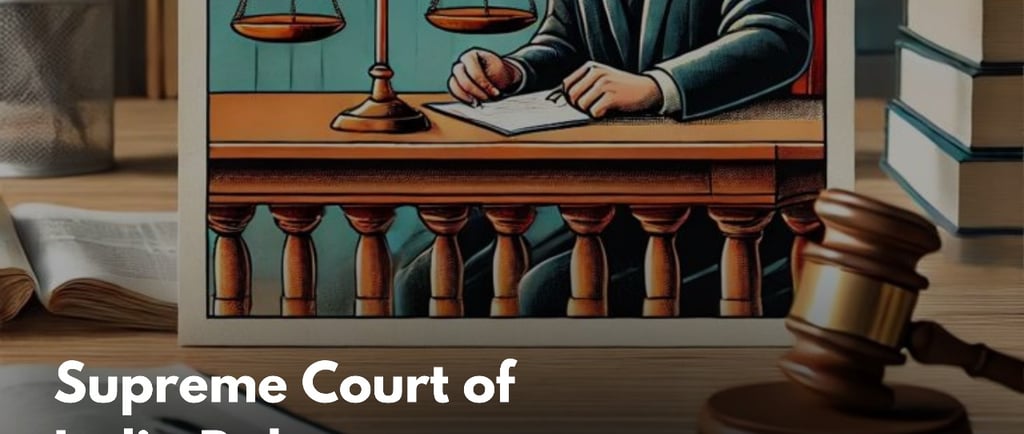Supreme Court of India Rules on Limitation in Specific Performance Cases: A Landmark Decision
On January 8, 2025, the Supreme Court of India delivered a landmark judgment in Indian Evangelical Lutheran Church Trust Association v. Sri Bala & Co., addressing the legal implications of time limitations in cases involving specific performance of contracts. The decision, authored by Justice B.V. Nagarathna, clarified the application of the Limitation Act, 1963, in circumstances where a fresh suit is filed after rejection of a prior plaint on similar grounds.
1/14/20253 min read


On January 8, 2025, the Supreme Court of India delivered a landmark judgment in Indian Evangelical Lutheran Church Trust Association v. Sri Bala & Co., addressing the legal implications of time limitations in cases involving specific performance of contracts. The decision, authored by Justice B.V. Nagarathna, clarified the application of the Limitation Act, 1963, in circumstances where a fresh suit is filed after rejection of a prior plaint on similar grounds.
Background of the Case
The dispute arose over a 5.05-acre property known as Loch End in Kodaikanal, originally acquired by American missionaries of the Lutheran Church Missouri Synod in 1912. In 1975, the property was transferred to the Indian Evangelical Lutheran Church Trust Association (the defendant) through a trust agreement. The plaintiff, Sri Bala & Co., sought to acquire the property under a 1991 agreement for ₹3.02 crore, making an initial payment of ₹10 lakh. Despite partial possession being handed over, disputes over tenancy and other issues delayed the transaction.
In 1993, the plaintiff filed a suit for specific performance to enforce the sale agreement, which was rejected in 1998 due to non-payment of court fees. Subsequently, in 2007, a second suit was filed by the plaintiff on the same grounds, leading the defendant to argue that the second suit was barred by limitation under Article 113 of the Limitation Act.
Supreme Court’s Observations
The Supreme Court, overturning decisions of the Madras High Court and trial court, held that the second suit filed in 2007 was time-barred. The Court emphasized that under Article 113 of the Limitation Act, the right to sue accrues when a cause of action arises, and subsequent suits must be filed within the prescribed three-year period.
Justice Nagarathna highlighted that:
The original cause of action occurred in 1993, and the rejection of the plaint in 1998 extended the limitation only until 2001.
The plaintiff's reliance on a letter allegedly extending the time for performance of the contract was inconsistent with the facts of the original suit.
The second suit, filed after a delay of nine years, represented an attempt to prolong litigation and was deemed speculative and time-barred.
Legal Reasoning
The judgment provided clarity on the interplay between Order VII Rule 11(d) and Order VII Rule 13 of the Code of Civil Procedure (CPC), 1908. While Rule 13 permits the filing of a fresh suit following the rejection of an earlier plaint, the Court underscored that such suits must adhere to the prescribed limitation period.
The Supreme Court rejected the plaintiff’s argument that pending litigation and alleged extensions justified the delay. The Court observed that the plaintiff had already filed an earlier suit in 1993, demonstrating that the cause of action was ripe at that time. Thus, no subsequent event could justify the filing of the second suit in 2007.
The Court relied on precedents, including T. Arivandandam v. T.V. Satyapal (1977) and Raptakos Brett & Co. Ltd. v. Ganesh Property (1998), to assert that the plaint must be read holistically to determine if it is barred by law. It reiterated that procedural provisions such as Order VII Rule 11(d) are crucial to preventing vexatious and meritless litigation.
Broader Implications
This ruling has significant implications for litigants and courts handling specific performance cases:
Strict Adherence to Limitation: The judgment reinforces the need for timely filing of suits and adherence to statutory limitations to ensure judicial efficiency.
Avoiding Speculative Litigation: By rejecting attempts to revive claims through extended litigation, the Court aims to reduce frivolous lawsuits that burden the judiciary.
Clarification on Procedural Rules: The decision provides valuable guidance on the application of Order VII Rules 11 and 13, balancing procedural fairness with substantive justice.
Conclusion
In a landmark decision, the Supreme Court upheld the principle that statutory limitations are critical to the fair and efficient functioning of the justice system. By dismissing the second suit as time-barred, the Court reaffirmed the importance of procedural discipline and timely action in legal disputes. This ruling is expected to serve as a precedent for future cases involving similar issues, ensuring clarity and consistency in the interpretation of limitation laws.
